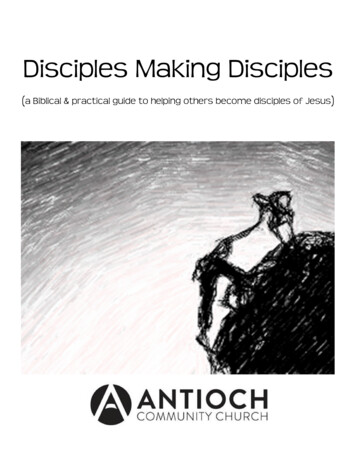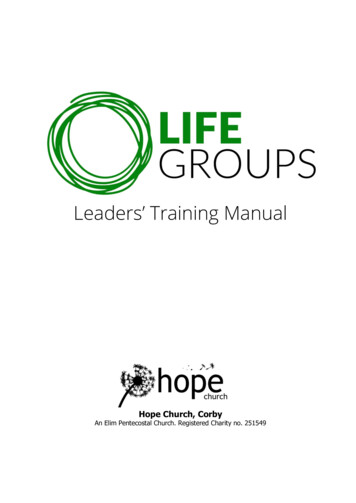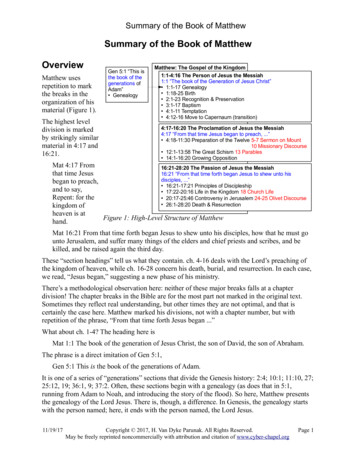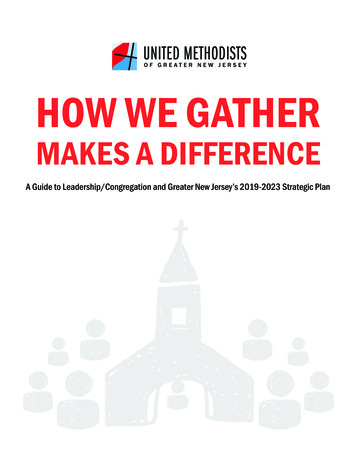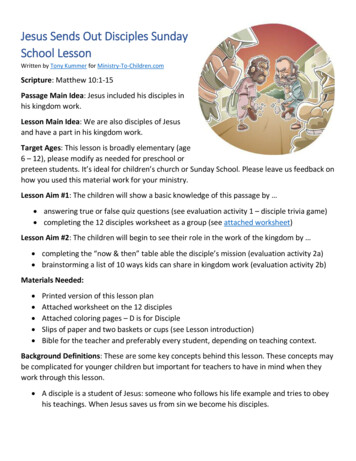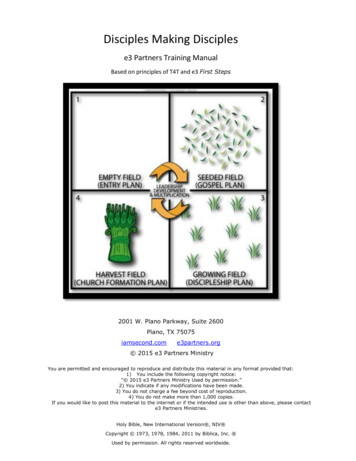
Transcription
Disciples Making Disciplese3 Partners Training ManualBased on principles of T4T and e3 First Steps2001 W. Plano Parkway, Suite 2600Plano, TX 75075iamsecond.come3partners.org 2015 e3 Partners MinistryYou are permitted and encouraged to reproduce and distribute this material in any format provided that:1) You include the following copyright notice:“ 2015 e3 Partners Ministry Used by permission.”2) You indicate if any modifications have been made.3) You do not charge a fee beyond cost of reproduction.4) You do not make more than 1,000 copies.If you would like to post this material to the internet or if the intended use is other than above, please contacte3 Partners Ministries.Holy Bible, New International Version , NIV Copyright 1973, 1978, 1984, 2011 by Biblica, Inc. Used by permission. All rights reserved worldwide.
Disciples Making Disciplese3 Partners Training ManualBased on principles of T4T and e3 First StepsContentsAcknowledgements . 3How to Use This Training Manual . 4Four Fields: See The Lord’s Vision . 6Field 1: Empty Field – Start with Friends & Family. 10Field 1: Empty Field – Find a House of Peace. 12Field 1: Empty Field – Go & Pray . 15Field 2: Seeded Field – Sow the Reproducing Gospel . 16Field 3: Growing Field – Multiply Disciples in Small Groups . 19Field 4: Harvest Field – Become a Church . 23Field 5: Multiply Leaders . 24Trainer Notes. 28Four Fields: See The Lord’s Vision . 28Field 1: The Empty Field – Go & Pray . 30Field 3: Growing Field – Multiply Disciples in Small Groups . 30Field 4: Harvest Field - Become a Church . 31Sample Training Schedules. 32Simple Group Guide . 35 June 2015Disciples Making Disciples2
AcknowledgementsThe project team for the Disciples Making Disciples training manual recognizes the followingsources and authors for their contribution to this manual:1) The e3 publication of First Steps training manual2) The Four Fields of Kingdom Growth – Mark 4:26-293) Smith, Steve and Kai, Ying. T4T: A Discipleship Re-Revolution. Monument, CO:WIGTake Resources, 20114) The I Am Second Simple Group Guide June 2015Disciples Making Disciples3
How to Use This Training ManualPurpose: God is at work expanding his kingdom. He is using ordinary, but deeply committed,people to multiply disciples and churches all over the world. This training manual was writtento train you to be a part of God’s movement of multiplying disciples and churches — and equipyou to train others.Training Manual Components: This training manual has three parts:1) The Training Manual teaches the principles of kingdom expansion throughmultiplication of disciples and churches. It is organized to help you train others inthese principles. This is your training outline. The section within each module titled“Discovery Groups” lists the most reproducible questions to use with your disciples.The section titled “Large Group Discussion: Additional Learning” can be used foradvanced training.2) The Trainer Notes contain training tips, demonstrations and supplementalinformation not contained in the training manual.3) The Simple Group Guide is a small group curriculum for training multiplyingdisciples, and helping the groups become New Testament churches. It contains“Hope” lessons for people who are open, but not yet ready to make the commitmentto follow Jesus; “Short Discipleship” lessons for new believers and; a plan for longterm discipleship to continue until Jesus comes again. The Simple Group Guide is tobe copied and handed out to trainees. It will serve as their “Lesson Plan” as theystart new groups. You will refer to it frequently while training.Training Goals: This training is a beginning. It is enough for a person to evangelize and startsimple discipleship groups that become healthy New Testament churches. To do this, traineesmust learn the following:1) How to find and recognize a person of peace.2) How to share the gospel and train a new believer to share the gospel. Be sure toallow 1½-2 hours for “Prayer Evangelism” practice in the field. This will be the mostimportant experience for many of your disciples.3) How to start a new simple group and follow the Hope lessons for people open to thegospel and the Short Discipleship lessons for new believers. The Short Discipleshiplessons will guide the new group toward becoming a healthy New Testament church.As much as possible, use the 3/3rds small group format in your training. This will helpparticipants become comfortable with this type of small group. The Hope lessons and most ofthe Short Discipleship lessons can be easily understood from the Simple Group Guide.However, the “Church Circles” activity in Short Discipleship Lesson 8 needs to be explained andpracticed. Often it is worthwhile to practice Short Discipleship Lesson 3 on baptism becausethe idea of immediate baptism is different from what is practiced in many churches, and mayneed to be explained.Focus first on these things – spending enough time for your disciples to become competent andconfident. Then, use any remaining time to cover other items. June 2015Disciples Making Disciples4
Train for Obedience: This training should lead to action. Learning without doing has littleeffect. So, the training focuses on teaching biblical principles and putting them into action.Jesus says: “Anyone who loves me will obey my teaching” John 14:23. Use illustrations andvisual demonstrations to help your disciples understand more deeply. (Some are provided inthe training manual and Trainer Notes. You and your disciples can create others). Train asmuch as you can in small Bible Discovery Groups. It is slower than lecture; but more likely tolead to obedient action. Allow enough time for disciples to practice the concept. They will onlydo what they feel competent and confident in doing. Practice brings competence andconfidence. If you are short on time, it would be better to teach and practice a few things thanto cover more material more quickly – but without practice.Advance Preparation: To train well, you must prepare thoroughly. Read through the trainingmanual, Trainer Notes, and Simple Group Guide. Then, practice the exercises you will beleading in the training. In particular, you need to be confident at:1) Telling the Bible stories found in Mark 5:1-20 and Luke 10:1-12,2) Sharing your personal story as taught in Short Discipleship Lesson 1 in the SimpleGroup Guide,3) Presenting the gospel as explained in Short Discipleship Lesson 2 in the Simple GroupGuide,4) The 3/3rds process,5) Hope Lesson 1 in the Simple Group Guide and,6) Short Discipleship Lessons 1, 2, 3, and 8, including the church circles activity in Lesson8.Sample Training Schedules: See Trainer Notes.Note to e3 Country Strategy Teams – Adapting this Material: Each country and peoplegroup has its own specific culture and situation. By necessity, this training manual choosesone approach: one evangelism method, one set of Bible discussion questions, one set of Hopelessons, and one set of stories for Short Discipleship. Also, it adopts a “storytelling” approachthat falls between strictly literate (based on reading the Bible texts) and strictly oral (based onoral transmission, without reading the text). We made these choices because they will beeffective in most of the world, most of the time. But, as a strategy team, you have the libertyto tailor your training to fit your specific situation.Before you make any changes to your training, please consult your Regional Director.1) Should we use a different reproducing evangelism method?2) Should we use different Discovery Bible questions?3) Should we use different sets of Bible stories and activities for Hope and ShortDiscipleship?4) Should we adopt a purely “oral” strategy that does not require literacy? This websitemight be suited to your specific situation: http://e3partners.org/causes/orality. June 2015Disciples Making Disciples5
Four Fields: See The Lord’s VisionKey Question – What is the Lord’s vision for building his Kingdom?Key Scripture – Matthew 28:18-20Trainer:Share a personal story of a current church planting movement. (If you do not have a personalexample, feel free to use the example from China included in the Trainer Notes.)Discovery Groups:Form groups of three to five people. Have each group select a leader. (By the end of thetraining, make sure every group member has had an opportunity to lead).Read Matthew 28:18-20 and discuss:1) What did you learn about God, Jesus, or the Holy Spirit?2) What did you learn about people?Have someone read the story aloud.3) Is there a sin to avoid? Promise to claim? Example to follow? Command to obey? (Lookfor “sins”, “promises”, “examples” or “commands” that are plainly in the story. Don’texpect to find all of them in every story.)Large Group Discussion Additional Learning:1) What does Jesus command his disciples to do in this passage? [go, baptize, makedisciples, teach them to obey all I have commanded].2) What kind of disciples doescommanded]. Our disciple-making Our disciple-making Our disciple-makingcommands.Jesus want us to make? [disciples who obey all he hasis not finished when we make a convert.is not finished when we teach them Bible doctrine.is only finished when the disciple does what Jesus3) What does Jesus command?a. Name one command that Jesus gives.b. When Jesus was asked what the most important command was, what did hesay? [Love God and love your neighbor, Matthew 22:36-40].c. What command do we find here, in Matthew 28? [Make disciples].d. So, at a minimum, your disciple should: 1) love God, 2) love people, and 3)make other disciples who do the same. Obedient disciples make disciples. So,the Great Commission creates a multiplying cycle: June 2015Disciples Making Disciples6
Command:"MakeDisciples"Teach themto obeyCommandsTrainer:Test: Are we obeying the Great Commission? The simple test: look behind you. If you areobeying the Great Commission, behind you will be following a chain of disciples makingdisciples making disciples. If this is not true in your life, you are not yet obeying the GreatCommission.Demonstration:Trainer should demonstrate, visually, the difference between evangelism and GreatCommission disciple-making. Training Tip: See “Leader A & Leader B” demonstration in theTrainer Notes.Trainer:Transition: Summarize the Four Fields Church Planting Movement diagram as an introductionto the rest of the training. Mark 4:26ff “He also said, ‘This is what the kingdom of God is like. Aman scatters seed on the ground ’”Your basic task is to tell people about Jesus and start simple Bible discovery groups – wherethey can learn to love God, love people and make disciples who do the same. Over time, thesesmall groups will become simple, New Testament, churches. Because they are so simple,these churches can quickly multiply.Like farming, there is a cycle involved. June 2015Disciples Making Disciples7
WHO?WHAT?HOW?HOW?Mark 4:26-28Trainer:This diagram explains the cycle. It represents the “Four Fields” of kingdom multiplication.Field 1. The first field (the top left) represents the empty field: the place (or people group)where the gospel is absent. We must begin with an entry strategy. How will we get there?How will we stay there long enough to share the gospel? Who will we share the gospel with?So, in the first field, our key question is: “Who?” “Who will we share the gospel with?”Field 2. The second field (top right) represents the seeded field, the place where the gospel isbeing sown. Here, we are beginning to present the gospel. We must understand both thescriptures and the culture so we can explain the gospel in a simple, culturally appropriate, way.It must be simple so that it can reproduce. The key question is: “What?” “What will we say toexplain the gospel?” Our goal is a “reproducing gospel.” A “reproducing gospel” presentationmust be: 1) Biblical, 2) clear & easily understood by the local people, 3) easy to train others.Field 3. The third field (bottom right) represents the growing field. We have entered the emptyfield and sown the gospel broadly. Some have turned to Jesus, and are beginning to growspiritually. We must make disciples – teaching them to obey Jesus’ commands. We mustimmediately establish the foundational habits of spiritual growth: learn what the Bible says, doit, and share it with others. We will need a plan for short-term discipleship (establishing afoundation in the first few weeks) and long-term discipleship (for life-long spiritual growth). June 2015Disciples Making Disciples8
The discipleship plan must be simple so that it can reproduce. It will be based on small groupsthat do not require special buildings, paid staff or extensive leadership training. The keyquestion is: “How?” “How will we make obedient, reproducing, disciples?” Our goal is“reproducing discipleship”: a method of discipleship that is: 1) biblical, 2) effective for the localpeople, and 3) easy to train others.Field 4. The fourth field (bottom left) represents the harvest field. The small groups of newdisciples become healthy New Testament churches. Only healthy churches will grow andmultiply in the long term. Therefore, we must have a plan to help our (field 3) discipleshipgroups become healthy churches. The key question is: “How will we form healthy churches?”Our goal is “reproducing churches”: a method of guiding small groups toward becoming healthyNew Testament churches who will then plant more churches.Field 5. The fifth area (the circular arrows in the center of the diagram) represents multiplyingleaders. At every stage we need leaders. We need leaders to enter a new field; to sow thegospel; to form discipleship groups; to guide church formation and; to multiply the process allover again. If we cannot multiply leaders, we will not see a movement. The key question is:“How will we multiply leaders?” Our goal is “reproducing leaders”: a method of finding andtraining leaders that will quickly enable them to find and train more leaders.In the remainder of this training manual, we will talk more about each of these five key areas. June 2015Disciples Making Disciples9
Field 1: Empty Field – Start with Friends &FamilyKey Question – Who will I share the gospel with?Key Scripture – Mark 5:18-20Trainer:“Who will I share the gospel with?” There are two answers to this question:1) First, if you are working in an area where you already know people, go to the people youalready know: your family, friends, co-workers and other acquaintances. This Sectiontalks about how to reach your friends and family.2) Next, you want to find “persons of peace” and “houses of peace” who are God’sprepared people. We discuss this approach in “Field 1: Find a House of Peace” inthis training manual. Once you find a house of peace, train them to reach theirfriends and family.Jesus commands us to go and make disciples of all nations. But, we have to start somewhere.The best and easiest place to start is with our own friends and family.WHO?Trainer:In each of the following passages, God uses one person to save the people close to him.Genesis 6:17-18 (Noah and his family), Genesis 19: 12-16 (Lot and his family), Joshua 6:1725 (Rahab and her family), Mark 5:18-20 (the Gadarene demoniac and his friends andfamily), Acts 10:24-46 (Cornelius and his friends and family), Acts 16:14-15 (Lydia and herhousehold), Acts 16:27-34 (Philippian jailer and his household). Again and again, God uses oneindividual save his or her family and friends.God has placed you where you are to reach the people you know. It is God’s will for you to winyour family and friends to Christ. Evangelism is most effective when it comes from someonewho knows you and loves you. So, the best place to start is where you are; with the peopleyou already know. June 2015Disciples Making Disciples10
Discovery Groups:Gather in groups of three to five people. Have each group select a new leader.Trainer:Tell the story of Mark 5:1-20, in your own words, as follows:1) Introduction: “I am going to tell you a true story from the Word of God. I want you tolisten very carefully because, after I tell you the story, one person in each group will retell the story to his group.”2) Tell the story. (Pay particular attention to verses 18-20).3) Closing: “That is the end of the true story from the Word of God.”Discovery Groups:Discuss Mark 5:1-20One person re-tells the story (with help, as needed, from the rest of the group).Discuss:1) What did you learn about God, Jesus, or the Holy Spirit?2) What did you learn about people?Have someone read this story aloud.3) Is there a sin to avoid? Promise to claim? Example to follow? Command to obey? (Lookfor “sins”, “promises”, “examples” and “commands” that are plainly in the story. Don’texpect to find all of them in every story.)Discovery Groups:Practice the activity (Make a List; Tell Your Story) from Short Discipleship Lesson 1 in theSimple Group Guide. June 2015Disciples Making Disciples11
Field 1: Empty Field – Find a House of PeaceWHO?Key Question – Who will I share the gospel with?Key Scripture – Luke 10:1-12Discovery Groups:Gather in groups of three to five people. Have each group select a new leader.Trainer:Tell the story of Luke 10:1-12, as follows:1) Introduction: “I am going to tell you a true story from the Word of God. I want youto listen very carefully because, after I tell you the story, one person in each groupwill re-tell the story to his group.”2) Tell the story.3) Closing: “That is the end of the true story from the Word of God.”Discovery Groups:One person re-tells the story (with help, as needed, from the rest of the group).Discuss:1) What did you learn about God, Jesus, or the Holy Spirit?2) What did you learn about people?Have someone read this story aloud.3) Is there a sin to avoid? Promise to claim? Example to follow? Command to obey? June 2015Disciples Making Disciples12
Large Group Discussion Additional Learning:1) Summarize Jesus’ instructions in Luke 10: Go where God sends you Pray for laborers Enter the area proclaiming the Kingdom Do not waste time or get distracted Visit the house of peace candidate, engage him and family if possible Give greetings/ask spiritual interest type of questions If favorable response, give blessing and ask evangelistic questions; ifunfavorable response, move on to the next place. Stay in the house of peace Fellowship with them Look for spiritual hunger2) Look specifically at verses 5-7. What does Jesus tell his disciples to do? What doeshe tell them not to do? [Do: Greet, evaluate response, if favorable response, stay, eat, drink.] [Do Not: Go from house to house.]3) Why? Why does Jesus tell them not to go from house to house?4) In Luke 10, Jesus does not explain why we are to search for a person of peace, andnot go from house to house. Perhaps we can learn why by looking at otherexamples in the New Testament. Ask participants, “Can you think of any examplesin the New Testament where Jesus, or one of the disciples, goes into a new place toevangelize, finds an open person, and stays with that person?” [Possible answers:Zaccheus, Samaritan woman at the well, Cornelius, Lydia, Philippian jailer, GadareneDemoniac].5) For each of these example ask: Did the evangelist (Jesus or Peter or Paul) need to go from house to houseafter they found that person (Zaccheus, Samaritan woman, Cornelius,Lydia, etc.) to effectively evangelize that area? Why not? [It was notnecessary to go from house to house because the person of peace gatheredtheir friends and family]. What would have happened if, instead of staying with the person of peace,the evangelist had asked that person (Zaccheus, Cornelius, Samaritanwoman, etc.) to come to their church or Bible study, or evangelisticmeeting? [Perhaps that one person would have come; but the evangelistwould have missed the opportunity to reach their friends, family andneighbors]Trainer:Who is a Person/House of Peace?A person of peace is not just a friendly person, not just a person who offers hospitality. In thegospels, Jesus tells us what we are looking for: June 2015Disciples Making Disciples13
1) Open to the gospel: A person of peace is an unbeliever who has been prepared bythe Holy Spirit and is ready to receive the gospel.2) Reputation: A person of peace is well-known in their community, whether for goodor for bad. Some biblical examples had a good reputation, like Cornelius. Otherswere well-known for their bad reputations, like the woman at the well and Zaccheus.Yet when each accepted Christ, their character was radically changed. God gainedthe glory for this transformation.3) Circle of Influence: A person of peace is willing to introduce his or her circle ofinfluence to Christ. They tell others about the great things Jesus has done for them.4) Helpful: A person of peace is willing to help Christian workers.“Test” for a Person of Peace: When we meet a person who is interested in spiritual things,we can simply ask: “do you have friends or family members who would be interested inhearing what we have been talking about?” If they are a person of peace (like Cornelius or theSamaritan woman) they will probably have a number of people they know who also need tohear the gospel. Help the person of peace to make their own friends and family list and trainthem to share the gospel with the people on the list.Are you eating the fruit, or planting an orchard?Think of a ripe piece of fruit. It is good to eat. But it is good for more than that. Ifyou cut it open, it is filled with seeds. Each seed, if planted and cared for, has thepotential to become a fruit tree – that will produce many fruit. In that one piece offruit, there is the potential for an orchard of many, many fruit trees – all of themproducing fruit. But, often, we scoop out the seeds, throw them away and eat thefruit.A person of peace (think of Cornelius or Lydia or the Samaritan woman at the well) islike a piece of fruit. Often, when we find a spiritually open person, we invite them toour church or our cell-group. That is great! We have added one more member. Thatis like eating the fruit and throwing out the seeds. It is delicious, but there’s only one.It is even better if we can see the “seeds” within them – the potential to reach theirmany friends and family members. We can focus our attention on the person of peace,in their own house or place of business. We can stay with them, eat with them andhelp them start a small group or church in their own place – so that they can reachtheir own village with the gospel. In that way we can be used by God to plant an“orchard” of fruitful believers beginning with the person of peace. June 2015Disciples Making Disciples14
Field 1: Empty Field – Go & PrayWHO?Key Question – Who will I share the gospel with?Key Scripture – Luke 10:1-3Trainer:“Prayer Evangelism” is a simple method for finding a house of peace. The idea comes fromLuke 10. It is not complicated. We go to the place where God is calling us. We walk throughit, usually in pairs. As we walk, we pray for the needs we see. While walking and praying,we talk to people we encounter - asking if we can pray for them. Often, offering to pray willopen the door for a spiritual discussion and allow us to find spiritually open people who mightbe people of peace.Trainer:Explain “Getting Started with Prayer Evangelism” from the Trainer Notes. (Later, we willtake a few hours to send the whole team out, two by two, to do prayer and evangelism inthe nearby community.) June 2015Disciples Making Disciples15
Field 2: Seeded Field – Sow the ReproducingGospelWHAT?Key Question – What will I say to explain the gospel?Key Scripture – Romans 6:23Trainer:What is the good news? Most religions have a set of rules. They teach that if you follow therules, God will accept you. Hindus are required to make sacrifices to their gods and are notpermitted to eat beef. Muslims are required to pray five times a day and are not permittedto eat pork. They work hard to follow the rules, in hope that God will accept them.Biblical Christianity is different – not because it has better rules. Christianity teaches thatnobody can follow the rules well enough to earn God’s acceptance. We all fail. We all breakGod’s rules and deserve to die and go to Hell. But God did an amazing thing: he took ahuman body and came to Earth. That’s Jesus. He lived a perfect life and never did anythingwrong. He’s the only man who did not deserve to die. But he died. He was falsely accused,unjustly tried, tortured and crucified. When he died, he was not paying for his own sins – hedidn’t have any. He was paying the price that we deserved to pay. Then, he rose from thedead – demonstrating his power and proving his worthiness. Now, God offers us forgivenessand new life – not because we deserve it, but because he paid for it. To us, it is a free gift.It is God’s grace. It cannot be earned. It can only be accepted, with love and thanks.That is the gospel. It is not about what we do to earn God’s acceptance. It is about whatGod has done to bring us back to him.There are many different methods and tools that can be used to explain the gospel. Lesson 2of Short Discipleship teaches one simple method. Learn it and try it – at least 100 times.After trying it, you may decide that another method would be more effective where you are June 2015Disciples Making Disciples16
working. That’s fine. Just be sure it is: 1) biblical, 2) simple and easily understood by thelocal people, and 3) easy to train others to use. If it requires extensive training or expensivematerials, it will not reproduce.Demonstration:Demonstrate for the large group the Activity in Lesson 2 of Short Discipleship contained inthe Simple Group Guide – Creation to Christ. Training Tip: Be sure to emphasize What to DoIf They Say “Yes” in Lesson 2 of the Short Discipleship.Pair up & Practice:Then, pair up and let each person practice telling the Creation to Christ story.Pair up & Practice Again:Pair up with a different person, and give each person a chance to practice telling the Creationto Christ story.Duckling DiscipleshipWhen we train a new believer to evangelize his or her friends and family, we are doing“duckling discipleship”. Think of a mother duck leading her ducklings to water. Theyusually walk in a single file. Only the first duckling follows the mother. The rest followanother duckling. The duckling does not need to be a mature duck to lead the one behindit. It needs only to be one step ahead of the next duck.The same is true of our spiritual lives. Jesus is the only One who is totally mature. Weeach follow and learn from someone one step ahead of us in maturity. And even thenewest disciple can lead someone who is at least one step behind him. So, even a newbeliever can teach someone who does not yet know Christ. They may not know much,but they know something. They know how to believe in Jesus. And they can teach that totheir friends and family. In that way, even the newest believer can obey Jesus’ GreatCommission command to “make disciples.”As the Apostle Paul said, “Follow my example, as I follow the example of Christ.”I Corinthians 11:1 June 2015Disciples Making Disciples17
Demonstration:Use four volunteers to visually demonstrate “duckling discipleship” as the ducklings followtheir mother and their brothers and sisters.Field Practice: Allow 1½ to 2 hours for the participants to do prayer evangelism (in pairs).As they meet people, they should share their story (which they practiced in Session 2) or theCreation to Christ story. Before they go:1) Review “Getting Started with Prayer Evangelism” from the Trainer Notes,2) Remind them of what to do if they say “yes”, from Lesson 2 of Short Discipleship inthe Simple Group Guide. June 2015Disciples Making Disciples18
Field 3: Growing Field – Multiply Disciples inSmall GroupsHOW?Key Question – How can we make obedient, multiplying disciples?Key Scripture – Matthew 28:20Trainer:We are now in the third field. We are looking for a “reproducing discipleship” plan. Biblicaldiscipleship, always, is based on a personal, loving, relationship. The discipleship groups weare forming will only work if the group members g
The Hope lessons and most of the Short Discipleship lessons can be easily understood from the Simple Group Guide. However, the “Church Circles” activity in Short Discipleship Lesson 8 needs to be explained and practiced. Often it is worthwhile to practice Short
